https://www.familytreedna.com/public/fairbairn?iframe=ymap
http://freepages.rootsweb.com/~gallgaedhil/genealogy/haplo_armstrongs.htm
https://www.familytreedna.com/public/fairbairn?iframe=ycolorized
https://named.publicprofiler.org/
The Elliott, Irwin, Farris and Fairbairn matches
from; DNA Lineages Companion site to DNA Surnames
added 12/18/2017 MSE
http://www.therjhuntercollection.com/resources/muster-rolls-c-1630/search-muster-rolls/
The Riding Clans in Ulster
‘Sheep stealers from the north of England’: the Riding Clans in Ulster
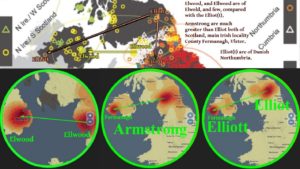
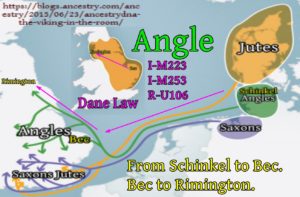
PoBI Viking settlement in England by Jane Kershaw & Ellen C. Royrvik
Match Cave and Gresham Y-DNA exactly at 12 markers, for 28 generations back is the same as a 37 marker exact match;
Info added 12/13/2018 MSE
http://www.elwald.com/armstrong-origins/
Osberne Bulax had two sons named Siward Barn the Red and Siward Barn the White (Fairbeorn). Not much is known of Siward the Red, but it is known that Siward Barn the White became a refugee and fled to Scotland with many other men of distinguished renown including Edgar, the Atheling, the rightful King of England.
Siward, the Fairbairn, was said to be of giant-like stature and a strong
man, blue-eyed, very fair with light hair and beard.
Note; since there was a Siward Barn (bear variant), the Red (red hair) and the White (likely white hair not skin), and Fairbairn is said to be very fair, and blue-eyed, it is felt at this time that “fair” means a person which is “fair”, and “bairn” is from “barn” which is from the Germanic “bär” spell in English because the English do not have the character “ä”, as “bear”, with the same pronunciation. There are many variants utilizing the name in many languages for “bear” which likely stems from a family northern Germany-south Denmark, and the beginnings of the spread of the influence of early Proto-Germanic languages.
Lowell,
After answering Rich Rucker question, am probably kicked way out of the FTDNA Armstrong project. Those Armstrong DNA guys likely do not want anything to do with me. Hopefully Fiona will forward.
Both the Armstrong and Elwald would use the Ninian name as a forename, and the pope came back on St Ninian day. There is even a St Ninian tartan which looks something like your Armstrong tartan. St Ninian, converted those Pictish Armstrong to Christianity. Do not know how well it took though. Was told when someone knocked on a door in old Liddesdale and asked if there were in Christians in there, they were told we’s Armstrang and Ellot.
The Little from Liddel, and Armstrong, most from Armystrand (army strand), Armistrang (strong army) along Liddel Water, and that is where the Picts, St Ninian of Whitethorne diocese converted to Christianity, and into northeast Scottland, where the Declaration of Abroath was signed, north of the Scandianavian Scottish Saint Andrews.
Fairbairn, is of the Germanic Bear family, of Burn, Barnes, Borne, Bourne, and many others, but likely of Siward Fairbairn, and the Y-DNA feel he carried was I-M253, because today about three forths of the family of Fairbairn carries this DNA.
Three forths of the family of Gresham, and also for the family of Scarborough carries my first twelve markers. Likely the quarter which does not match for over a period of eight centuries is because of adoption and Non Parental Events NPE.
Croyland near the Barony of Bourne (the bear). Lincolnshire, County, where it is felt the Danish Bourne family lived, near the family of Elwald of Croyland, with bones of St/King Elwald in Hexam Abbey. There was also a Viking named Ulf and The Horn of Ulf (meaning wolf), is stored in York, and I use it for a background to represent the geological horn of Gorrenberry.
Though it is felt that the Danish Bourne family with offspring, Fairbairn (fair skin Danish male), and Osborne (white shin Danish male), and other bear, Barnes, Burn, and etc. the Fairbairn are the family which is important to the Armstrong because they went north. The Barony of the Bourne, besides lands near the Elwald of Croyland, included land of Gresham near the Elwald of Bec, and Oulton in Norfolk, where my Y-DNA arrived as Anglo-Danes, and N&S Cave-Cottingham, where a William Elwald settled in the region of the Estutville-Wake estates. The land also owned by the Estuteville-Wake family of the land of Nicolas Stuteville Forrest, and The Mote/Moat, where Liddel Strength Castle was built and where latter the Graham family built a peel tower. They also had peels at Kirkandrews but after the church (kirk) of St Andrews of St Ninian’s Whitethorne diocese was abandoned the one which in 1423 a John Elwald which once rector in 1418 St. Andrews University, the first College of Scotland. Also Grahams had a peel at Netherbye (under by), a companion to Canonbye (canopy/upper/over by), which with no peel, likely unlike the peels of the Graham on the English side, Canonbye was considered on the Scottish side.
Clan Fairbairn though today about tenth the numbers of the Armstrong, you will find if you Google “Clan Fairbairn” and go to images one would see the Fairbairn, likely more of Siward Fairbairn DNA seems to support my ideas strongly.
Mark Elliott 5/29/2016
https://www.familytreedna.com/public/y-dna-haplotree/I
I-M253 Distribution;

https://www.familytreedna.com/public/armstrong?iframe=yresults
Armstrong FTDNA I-M253;
(Armstrong, many of Alexandir Armystrang; and army strand of the Liddel Water)
Armstrong GBname distribution 1881;
Armstrong GBname statistics;
Little-Liddell
(Little-Liddel, place name of the Liddel Water)
Little of I-M253 FTDNA
Little GBname statistics;
Little of I-M253 FTDNA
Fairbairn of I-M253 FTDNA
Fairbairn GBname distribution 1881;
(Fairbairn; fair bear; likely offspring Dane with fair skin called Bear)
Fairbairn GBname statistics;
Osborn(e)
(Osborn(e) likely and offspring of a white skin Dane named Bear)
(shows I-M253 in Norfolk-Lincolnshire UK region)
Osborn Osborne I-M253 Y-DNA
Osborn/Osborne (Danes with white skin, sometimes referred to as a Polar Bear) is felt to mainly enter into Anglia then migrate towards the west-southwest. It is felt that part of the I-M253 migrated north with the people of the Fairbairn (Danes with fair skin, sometimes referred to as a Fairy Bear).
http://www.elwald.com/barony-bourne-danish-bear/
Mark S. Elliott 5/29/2016
Conclusion Given;
Chronicles of the Armstrongs;by ED James Lewis A. MD, 1902
With Fairbairn surname, with about 75% having I-M253, is indicative that the body I-M253 is likely from someone with the name Fairbairn. The surnames Armstrong, which in 1376 was Armystrand, meaning army strand along a bank likely the Scottish side of the Liddel Water in which Armstrong peels were located.
Surname Little is known to be highly related to the Armstrong. and like the name is derived also as much of the Armstrong surname from the Liddel Water.
A group called Fairbairn similar group naming like religious groups, but of Fairbairn family origin. Origin Fairbairn, had an I-M253 Y-DNA, and likely of the same individual. People of the Fairbairn in high percent of I-M253 would take the Fairbairn surname, but smaller percent of Fairbairn among the Armstrong and Little surnames for obvious reason the surname is not Fairbairn.
Chronicles of the Armstrongs;by ED James Lewis A. MD, 1902
Bear;
Burns, Byrn, Byrne & Bentley (Bear I-253 DNA);
Distributions;
Bear I-M253 family;
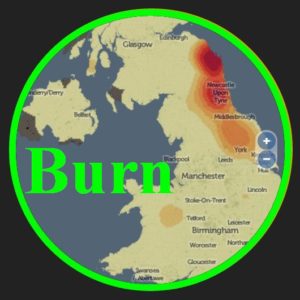
Burn of;
Burns, Bryne, Brynes, and Bentley; (some I-M253)
https://www.familytreedna.com/public/Byrne?iframe=yresults
has off springs Osborn(e), there offspring of likely a single male with I-M253 Y-DNA, of the Fairbairn family pre-surname which settle along the Scot-English border. The people of the Fairbairn, along the Liddel Water became Little and Armstrong, and the ones one the east side of the border, not along the Liddel Water, became Fairbairn, as shown by the high percent of I-M253 Y-DNA. The none I-M253 is felt having to been done by Non-Parental Events NPE such as adoption.
MSE 6/27/2016
For the R-M269 NPE they could be in relation to the Irvine-Elliot and other surnames;
31. Manifestations of NPEs • Egressions from a genetic family (“e-NPEs”): same DNA, but different surname e.g. Irwin DNA, but Elliot surname (possibly an Elliot step-father) • Introgressions into a genetic family (“i-NPEs”): same surname, but different DNA e.g. Elliot DNA, but Irwin surname (possibly an Irwin step-father) “One project’s e-NPE is another project’s i-NPE”. 31
32. Examples of Irwin / Elliot e- NPEs 32 ………..Elliott ………..Elliott ………..Elliott ………..Elliott ………..Irving ………..Erwin ………..Elliott ………..Erwin ………..Nipper ………..Irvine ………..McDonald ………..Armstrong …………Irwin …………Snowdon
33. Examples of Elliot / Irwin i- NPEs 33 ………. Elliott …………Fairbairn …………Fairbairn …………Elliott …………Elliott …………Elliott …………Elliott …………Farms …………Fairbairn …………Fairbairn …………Fairbairn …………Fairbairn …………Fairbairn …………Fairbairn
https://www.familytreedna.com/public/fairbairn?iframe=yresults (added 10/19/2018)
MSE 12/14/2016
May be interested in Irwin-Elliot(t) NPE; A Scots-Irish case study: the Irwin DNA Project (James Irvine) https://www.youtube.com/watch?v=YMcBkz79wQM&t=2823s
https://www.slideshare.net/FamilyTreeDNA/y-dna-surname-projects-some-fresh-ideas
https://www.familytreedna.com/public/irwin/default.aspx?section=yresults
Elliot(t)
https://www.familytreedna.com/public/elliott?iframe=yresults
above added 11-17-2017
The Carrothers/Carruthers, of Debatable Lands and Fermanagh also carry I-M253
It should be noted that Karruthers in above are of Dumbfrieshire below.
http://www.elwald.com/carruther-m253-y-dna/
NIXON I-M253;
Fermanagh, Ulster, Ireland;
‘Sheep stealers from the north of England’: the Riding Clans in Ulster by Robert Bell
Fermanagh (muster), c. 1631, copied from MSS. 4770 in the British Museum. The list is set forth by baronies and the names of the … Armstrong (41) ; Biaty (Beatty, Bayty, Baetye, Baiteye) (36) ; Ellot (33) ; Graham (29) ; Little (25) ; Irwin (17) ; Nixon (10) …
Repositories and records – Page 649 Margaret Dickson Falley – 1962 –
Graham (Grame, Græme) I-M253;
https://www.familytreedna.com/public/Graham?iframe=yresults
Johnston(e)-Johnson, also has a high number of I-M253;
https://www.familytreedna.com/public/Johnson/default.aspx?section=yresults
3/24/2017 MSE
Hamilton FTDNA results
Hamilton has a large proportion of I-M253, and many border Scots at time of Cromwellian Civil War, fought as Royalists on the side of Anglican Charles II, and the Anglican Hamilton.
10/4/2017 MSE
Garrett Hellenthal;
Résumé
Shows genetic migration into Ulster (Northern Ireland), from Argyll, Glasgow Region, and Liddesdale.
Liddesdale and Northumberland region of “orange rings” is where the Burn (bear) – Fairbairn (fair bear) are concentrated.
Showing marker 33 out of Germany influencing British DNA.
Anglo-Saxons seem to stop northword migration at border. Vikings-hit the Northumberland “orange rings” and Gaelic speakers which Dumfries was an area of them. So the Fairbairns, in Scotland just north of the east end of the border, and the Carruthers, of Carruthers Town, Dumfres on the west, are predominately Viking I-M253.
Where Did The Fairbairns Come From?
By Thomas Fairbairn March 12, 2010 at 02:04:40 from;
http://www.genealogy.com/forum/surnames/topics/fairbairn/499/
Although there is more than one story about the origins of the Fairbairns, perhaps one of the most widely accepted is the saga of Siward.The Viking, also known as Siward Fairbairn of the Strong Arm.Siward was the son of a Danish King and lived in England from about 995 till his death in 1056.In those days, the ruler of any small territory was a king, so exactly where his father, Hringo, King of Upland, also known as Earl Beorn, would fall on the yardstick of earthly royalty is not clear; however, at the very least, he would be considered of noble birth.
Whether Siward was born in England is also not known for certain.However, he was the first to carry the name of Armstrong and was listed in the History of England as having earned the right to the title of Earl of Northumbria (Northumberland) having been conferred the title by Edward the Confessor.
Siward, the Fairbairn, was said to be of giant-like stature and a strong man, blue-eyed, very fair with light hair and beard.The legend goes that Siward took ship and sailed with 50 of his men from Danemark, arriving at what is today called the Shetland Islands, where he is said to have encountered a dragon which he slew in single combat.Dragons, as most of us know, are mythical creatures which the dictionary states were first defined as a large serpent.He apparently got a kick out of killing serpents, as he put out to sea again and finally landed in Northumbria where he began looking for another one to fight with.Here he met an old man who he thought was his god, Odin, who told him he had already killed the dragon and for him, Siward, to sail southward to the mouth of the Thames river which could bring him to the wealthy city of London (one would think that there would have been plenty of serpents there).The old man then gave him a standard (flag) to carry which signified The Raven of Earthly Terror (Edgar Allen Poe must have read about our ancestor!)He was received by Edward the Confessor, the King of England, with much ceremony and was made many promises if he would stay with the King and help him fight to retain his kinship.
The following story about Siward had endured.One day, as he was leaving the court after an audience with King Edward, he was confronted by Tostig, Earl of Huntington, on a bridge, who insulted him by throwing dirt upon him.Siward took no offense at the time, but on confronting him on his return on the same bridge, the story goes that he decapitated Earl Tostig and carried his head back to the King.The king, being suitably impressed by this brawny warrior with violent tendencies, wisely awarded Siward the Earldom of Huntington in addition to Northumbria.
As Siward’s reputation as a brave and valiant knight continued to increase, so also did the kingdom of Edward continued to be visited by other Danes who held him and his people in much less esteem than did our good Siward.In fact, they became an ever-growing nuisance – arriving by ship and plundering the eastern coast of England.As the most of the havoc they created was located in Westmoreland, Cumberland and Northumbria Counties, some wise soul counseled the King to put Siward in charge of defending this area.White perhaps properly descriptive if not overly flattering, it was reportedly stated that it was best that the little devil should be first exposed to the great devil.
Siward goverened in peace the territory of Northumbria which extended from the Humber River to the Tweed River on the border of Scotland, and was greatly respected and loved by the Northumbrians who were chiefly of Danish extraction (better a danish devil than an English saint?). He orchestrated several forays from Northumbria to the north and was successful in putting all territory under the command of the King of England.
The surname of Siward was Beorn (meaning bear) and relates to the Nordic legends of the Fairy Bear or Fay Bairn, from which the Border name of Fairbairn, originated.The name was applied to the stories of Siward and his father and were called the fairy Bear Stories.
Siward had a sister (who’s name is not known) who married Duncan, the King of Scotland from 1034-1040 AD.Prior to his death in 1056, Siward suppoeted his nephew Malcolm, the rightful heir, against Shakespeare’s famous King Macbeth of Scotland who had killed Malcolm’s father King Duncan.
By 1070, the Battle of Hastings (1066) was over and England hsd been conquered by William of Normandy.Malcolm III had been on the Scottish throne since the death of Macbeth in 1057 and Siward has been dead since 1056.His first son, Osberne Bulax, was killed in the battle of Macbeth in 1054, some say by the hand of Macbeth, himself.Osberne is also said to have married the daughter of Lady Godiva.Siward’s second son, Waltheof (which means forest thief – nice name!) is alternately in and out of favor with William the Conqueror.For example, his wife, Juditha, is a niece of William and in 1069 we find that King William restored the earldom of Northumbria to Waltheof.However, in 1076 he was betrayed by King William and brought ot the outskirts of Westminister where he was beheaded.
Osberne Bulax had two sons named Siward Barn the Red and Siward Barn the White (Fairbeom).Not much is known od Siward the Red, but it is known that Siward Barn thw White became a refugee and fled to Scotland with many other men of distinguished renown including Edgar, the Atheling, the rightful Kinf of England.
Waltheof left no male descendant.However, Matilda (called Maude), his daughter (after her first husband died) married King David I, the son of King Malcolm of Scotland and his wife Margaret, who was the sister of Edgar the Atheling mentioned above.Both the Scottish and English royalty have descended from Waltheof to the present day.
Malcolm III, the 85th King of Scotland greeted Siward Barn the White (his cousin) with great kindness, and together they fought against William the Conqueor, driving him out of Northumbria.An interesting story apparently involves Siward the White Fairbeorn during a battle against England.During this battle, King Malcolm’s horse was killed under him partially crippling him and young Soward fought his way to the King’s side.Passing his left arm around the King’s body under his arms, he reportedly fought his way with a great Sword through the enemy to a place of safety.For his courageous act he was knighted by the King, given land and a castle on the Scottish border, and from that time on was referred to as the Sword of the Strong Arm (or Armstrong).This was how he and his decendants came to inherit the lands of MANGERTON in Liddesdale.
These lands (shown above), known as the Debateable Land, were disputed for centuries by both Scotland and England.As time went on they were protected by neither nation and, as the Armstrongs were of both Anglo and Danish descent, they were entirely different from the Celtic Clans of Northern Scotland.As a result of blood ties and loyalties not unlike those of the Mafia in Sicily some centuries later, these Clans avenged bolld for blood for centuries.In this environment it is not hard to understand how a reputation for plundering, bloodshed, and violence came to be tied to these marauders of the border lands.
Little is said about the Armstrongs after the building of the Mangerton Tower, probably in 1135.Apparently no Chief was immediately recognized until 1300 when Alexander became the first Lord of Mangerton.Stories abound of the enmity between the Armstrongs and their neighbors the Lodrs of Soulis, after being invited to a feast at his castle.The Armstrong Clan flourished, however, and by the early 1500s, the Laird of Mangerton was able to gather 3,000 mounted fighters.One Scottish king said that while there were Armstrong and Elliots on the Border, Scotland was safe.The Armstrongs were ambassadors, earls, knights, farmers and above all, fighters.For example, Gilbert Armstrong, third son of Alexander, the second Lord of Mangerton, a distinguished clergyman and diplomat was the Conon Moray from 1361 to 1375.In 1363 he served as a Commissioner to England for the ransom of King David II of Scotland who was held as aprisoner in England.In all there were ten Lords of Mangerton from Alexander through Archibald Armstrong who was denounced as a rebel in 1603, deprived of his lands in 1610, and executed at Edinburgh.
What happened to change our fortunes so greatly ? James IV of Scotland was on good terms with the Scottish Border chiefs and he regularly visited and was entertained by them.His son, James V of Scotland, on the other hand, ruled by decree from distant Edinbaugh and did little to protect his Border subjects or support them against repeated English incursions.In fact, in 1530, James V, with some 8000 men at arms surged into the borderlands and the betrayal of the Armstrongs began.Johnnie Armstrong, Laird of Gilnockie, was a much beloved nad highly respected member of the Armstrong Clan, who James V invited to parlay.Accepting the King’s invitation, he and 50 of his men went to meet with the King in good faith.Instead, they were seized and summarily executed.This incendiary act outraged the Armstrongs and their allies and set the Borders ablaze with rage and indignation – increasing the violence and bloodshed it was intended to suppress.At the prodding of the King, the Church also entered the fray and the Armstrong’s and other Border reivers were cursed by the Church excommunicated enmasse.The Armstrongs, with other Borderers, were thus left to their own devices so far as mutual self-defense was concerned.
Receiving neither aid nor comfort from the Scottish or from the English Crowns, the Armstrongs and other Border clans were forced to become makers of their own laws and protection.After Edward I of England slaughtered a thousand of Scots at Berwick, self-defense and preservation became their paramount endeavor.The Borderers were forced to become the best in what had become a profession – a greater thief (raider) did never ride was one complimentary description of an Armstrong.Jock O’Syde, in Liddesdale.They would raid by night and attend Carlisle Market by day, greeted by all who knew them.Unable to do more than bare subsistence farming, the cupboard was frequently bare.When the lady of the house served her Laird a pair of spurs on a plate, this meant it was time to ride and raid the other side of the Border yet again.
The bloodshed and violence continued.In 1603, Elizabeth I died and James VI of Scotland (James I Of England) was declared her heir.After a splendid coronation at Westminister Abbey, James settled down to life at the English Court.One of his highest priorities was the suppression of the Border families like the Armstrongs, as he was afraid that their incursions would make him unpopular in England.As a result, he established powerful landlords in the Debateable Land around Liddesdale and Eskdale, and appointed Sir William Cranston to put to death all within two miles of the border.A large number of Armstrong reivers were tortured and hung at the Market Cross in Edinburgh, at Carlisle and no doubt on a number of local gibbets.The last Armstrong raid of any importance took place in 1611 and for it, Lance Armstrong of Whithaugh – along with others – was executed a year later.Cranston generated the first forced migrations to Ireland and the subsequent Undertaking of the Plantation of Ulster in 1608.In the 18th century, farms were merged and more migrations followed.
The Armstrong lands of Mangerton passed into the hands of the Buccleuchs.Many members of the once powerful Armstrong Clan were shipped off to Ireland, including Johnnie Armstrong’s grandson, William who settled in Fermanagh.Thus, many who had survived found themselves on the Solway shore waiting for emigrant ships to take them from an inhospitable homeland.Homeless, leaderless, and sometimes penniless, they went westward to Ireland and North America, and south to Australia and New Zealand in search of new beginnings.Perhaps the most famous descendent of the Fermanagh Armstrongs was Neil Armstrong, the Americam astronaut and the first human to set foot on the moon during the Apollo 11 mission in 1969.
The dissolution and dispersal of the Armstrongs followed some two hundred years of Border brigandage and treachery, ending in the depopulated areas and vast estates of the present day Whithaugh, Mangerton and Gilnockie, which had at one time been the Clan’s greatest strongholds.A proud and courageous family had been reduced to a smattering of broken men.The Armstrongs have been scattered and now have neither chief nor recognized leader.However, as individuals the Armstrongs have survived and have lived up to their clan motto of ” Invictus maneo “or” We Remain Unvanquished. ”
Robin Hood is sometimes said to be the Earl of Huntington. Perhaps he is the son of The Fairbairn Earl of Huntington by another woman. I have found evidence online to support this theory.
Tom Fairbairn
graphic added 8-11-2019 MSE
P.S. According to recent DNA Testing, The Armsrongs are not related to the Fairbairns. This is according to Lorna Henderson. Someday we will have our own clan, without being part of the Armstrong clan.
11/5/2017 MSE
Clan Nixon I-M253;
3/18/2018 MSE
Dunbar & Cockburn Y-DNA U106 to S5750 near Scottish localities.
5/22/2019 MSE
JOHANNES WEYERS @mark !! We do not always have to prove the origin of the word “the” or ” German ” . Their are lots of origins of documents that are often conflicting . We all try to scratch and find those of value and in the process too often even prove ourselves wrong .
…….
Like Mark Elliott JOHANNES WEYERS In order for Elwald to be of the Fairbiarn I-M253 (Fair Bear) story in the genealogy of the children of the bear, ‘wolf’, and ‘elk’, the ‘elk’ can not be a big deer. It has to be a ‘moose’, what the English and German call an ‘elk’. Because Elwald is derived from ‘moose of the forest’. Since the ‘american elk’ is only in the forest, the name created a branch, family. The ‘moose’ in English and German ‘elk’, has a branch family in the genealogy of the family tree. It is the ‘moose/elk’ of the thickets and marsh. Never have seen an ‘American elk’ in the marshes-thicket, but have seen an ‘English-German elk’ in the marshes-thicket.
…….
Y-DNA by Robert P. Elliott, of our Daniel Elliot, of Salem cluster shows the Ker(r) to be a in the group of the closest matches by surname. https://d3tije9h5o4l4c.cloudfront.net/social-photos/2210825?dpr=2&fit=max&h=324&w=590 Image address showing ‘elk’ on the crest of the Kerr arms.; https://encrypted-tbn0.gstatic.com/images?q=tbn:ANd9GcQg3I3LAEyX4jy3CdXxqtNcQ7vVeSLUJbvk1h9Uqt37-hXCI3JERg
……
Clan Kerr – Wikipedia https://en.wikipedia.org/wiki/Clan_Kerr Clan Kerr /kɜːr/ ( About this sound listen) is a Scottish clan whose origins lie in the Scottish … The name stems from the Old Norse kjarr which means marsh dweller, and came to Scotland from Normandy, the French settlement of the … (note; the People of British Isles PoBI autosomal DNA study excluding surnames groups, the Anglo-Saxon, of the ‘elk of the forest’ DNA, with the Norman DNA, of the ‘elk of the marsh’, are in the same DNA grouping.)
……
The Ker(Cessford, Duke of Roxborghe of Floors Castle near Kelso, Scotland), Kerr(Ferniehirst, Chief of Clan Kerr a Tory, Lady Buccleuch), and Carr(adult accuser in the Salem Witch trials). Carr, a lady in this blog brought to my attention, her awards for the DAR Daughters of the American Revolution, and reminded me the pride my family that they took place in “stringing up those Tories”, especially when they laugh at “transporting the Scots as slaves to The Colonies”. https://gorrenberry.com/wp-content/uploads/2015/01/SELLING-SCOTS-AS-SLAVES-IS-FUNNY-TO-THE-TORIES-2.mp4?_=1 It was my family being transported, for being Royalists, like the Loyalists to the crown, but ninety years earlier. For me to get the language of my genealogy correct for my particular family is very important, but in order to do proper genealogy you better get it correct for your own family. The only family I basically have to utilize as a model for other families is my own. It is the mechanics which I am trying to teach. Like, the one who has done the genealogy and carries the Y-DNA, is most likely 100% in being correct. Listen to the ladies, ‘the Carr with the DAR awards’, do not kick out the ‘in-laws’, allow for ‘freedom of speech’, something I feel “The Americans”, need to learn from “The Europeans”, because they “The Europeans”, are beating “The Americans”, at their own game. Of course there are in America people from Europe including the UK.
5/28/2019 MSE
https://archive.org/stream/chroniclesofarms00arms/chroniclesofarms00arms_djvu.txt
Sagas of the Fairy Bear.
^^^^ORFOEUS the historian gives the Danish ver-
sion of this saga at some length. The follow-
ing is a short analysis of the ancient tale.
“Hringo, king of Upland, had an only son, called
Biorn, the most beautiful and most gallant of the nor-
thern youth. At an advanced period of life, the king
became enamoured of a ‘witch lady,’ whom he chose
for his second wife. A mutual and tender affection
had from infancy subsisted betwixt Biorn and Bera,
the lovely daughter of an ancient warrior. But the new
queen cast upon her stepson an eye of incestuous pas-
sion ; to gratify which, she prevailed upon her husband,
when he set out upon one of those piratical expeditions
which formed the summer campaign of a Scandinavian
monarch, to leave the prince at home. In the absence
of Hringo, she communicated to Biorn her impure
affection, and was repulsed with disdain and violence.
The rage of the weird stepmother was boundless.
* Hence to the woods!’ she exclaimed, striking the
prince with a glove of wolf-skin; * hence to the woods!
subsist only on thy father’s herds; live pursuing, and
die pursued ! ‘ From this time the prince Biorn was no
more seen, and the herdsmen of the king’s cattle soon
observed that astonishing devastation was nightly made
among their flocks by a black bear of immense size
and unusual ferocity. Every attempt to snare or destroy
this animal was found vain ; and much was the unavail-
ing regret for the absence of Biorn, whose delight had
been in extirpating beasts of prey. Bera, the faithful
mistress of the young prince, added her tears to the
sorrow of the people. As she was indulging her melan-
choly, apart from society, she was alarmed by the ap-
proach of the monstrous bear, which was the dread of
the whole country. Unable to escape, she waited its
approach, in expectation of instant death; when, to her
astonishment, the animal fawned upon her, rolled him-
self at her feet, and regarded her with eyes in which,
spite of the horrible transformation, she still recognized
the glances of her lost lover. Bera had the courage to
follow the bear to his cavern, where, during certain
hours, the spell permitted him to resume his human
shape. Her lover overcame her repugnance at so
strange a mode of life, and she continued to inhabit
the cavern of Biorn, enjoying his society during the
periods of his freedom from enchantment. One day,
looking sadly upon his wife, *Bera,* said the prince,
•the end of my life approaches. My flesh will soon
serve for the repast of my father and his courtiers. But
do thou beware lest either the threats or entreaties of
my diabolical stepmother induce thee to partake of the
horrid banquet. So thou shalt safely bring forth three
sons, who shall be the wonder of the North.’ The
spell now operated, and the unfortunate prince sallied
from his cavern to prowl among the herds. Bera fol-
lowed him, weeping, and at a distance. The clamour
of the chase was now heard. It was the old king,
who, returned from his piratical excursion, had collect-
ed a strong force to destroy the devouring animal which
ravaged his country. The poor bear defended himself
gallantly, slaying many dogs, and some huntsmen. At
length wearied out, he sought protection at the feet of
his father. But his supplicating gestures were in vain,
and the eyes of paternal affection proved more dull than
those of love. Biorn died by the lance of his father,
and his flesh was prepared for the royal banquet. Bera
was recognized, and hurried into the queen’s presence.
The sorceress, as Biorn had predicted, endeavoured to
prevail upon Bera to eat what was then esteemed a
regal dainty. Entreaties and threats being in vain,
force was, by the queen’s command, employed for this
purpose, and Bera was compelled to swallow one morsel
of the bear’s flesh. A second was put into her mouth,
but she had an opportunity of putting it aside. She
was then dismissed to her father’s house. Here, in
process of time, she was delivered of three sons, two of
whom were affected variously, in person and disposition,
by the share their mother had been compelled to take
in the feast of the king. The eldest, from his middle
downwards, resembled an elk, whence he derived the
name of Elgford. He proved a man of uncommon
strength, but of savage manners, and adopted the pro-
fession of a robber. Thorer, the second son of Bera,
was handsome and well-shaped, saving that he had the
foot of a dog, from which he obtained the appellation
of Houndsfoot. But Bodvar, the third son, was a
model of perfection in mind and body. [These names
correspond to the first Liddesdale names of Elkwald,
Loumaine, and Fairbairn.] He revenged upon the
necromantic queen the death of his father, and became
the most celebrated champion of his age.” [Historia
Hrolfi Krakae Haffniaey 171 5.)
Saxo Grammaticus, who wrote about Siward’s time,
gives a more plausible but nevertheless wild enough
version of this story. He mentions Beorn and Siward’s
names. The next version, which is told by Johannis
Bromton in the Chronicon, is stated by Ridpath to have
been the one recited upon the Border.
“There was in Denmark a noble Earl of Blood
Royal that had one only daughter who to recreate her-
self, walking with her maids into a wood not far from
her father’s house met with a Bear, which bear having
put the maids into so great a fright as caused them to
flee, seized upon the Damsel and then ravished her by
which rape she brought forth a son that had ears like a
bear who was thereupon called Beorn and succeeded in
that Earldom. This Earl of the Arm Strong had a son
named Siward.” (Bromton.)
The third version of the Fairy Bear was recited in
Fermanagh. It runs as foUows. “There was in olden
times a witch who hated her son who married a fay.
So the wicked mother changed her son to a Bear
and the only way he could get anything to eat was
by killing the Deer of the forest [or Elks of the
wood; that is, the Elwods], the flocks of the fields
[Far bairns], and the wolves of the desert [Lou-
maines]. One day he met his wife in the woods and
she immediately knew him by his eyes. After that
she met him frequently. At last he was killed by some
Forresters. After his death his wife had three children
the first was like a Wolf, the second like a deer, and
the third was like a sheep (or bear) and very fair.” In
Denmark the White Bear was called Asa’s bear and
the Fairy Bear, whence comes the name Osbeorn.
(Grimm.)
The following is the Terwinney version of the Fay-
bairn. “The first Armstrong married a dark eyed fay
with a wealth of rich black hair, she was called a prin-
cess. Until that time our ancestors had blue eyes and
fair hair and they were therefore called such names as
Fair Johnnie and Fair Billie but after that we had Black
Armstrongs and White Armstrongs.”
8/11/2019 MSE
Calling All Fairbairns
For all interested in the FAIRBAIRN (and variants) surname – this blog is the project diary for both the One Name Study and the DNA Project
10/27/2019 MSE

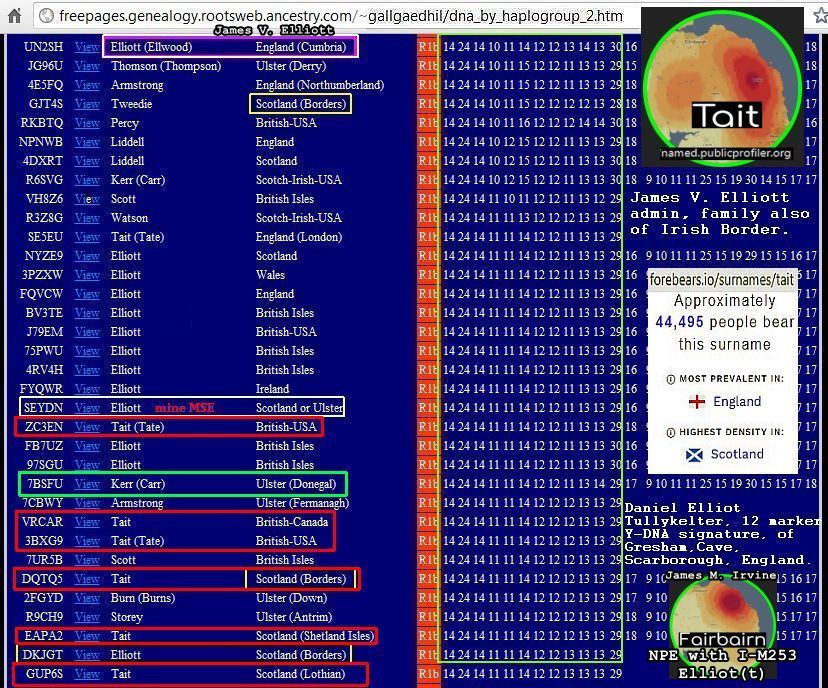
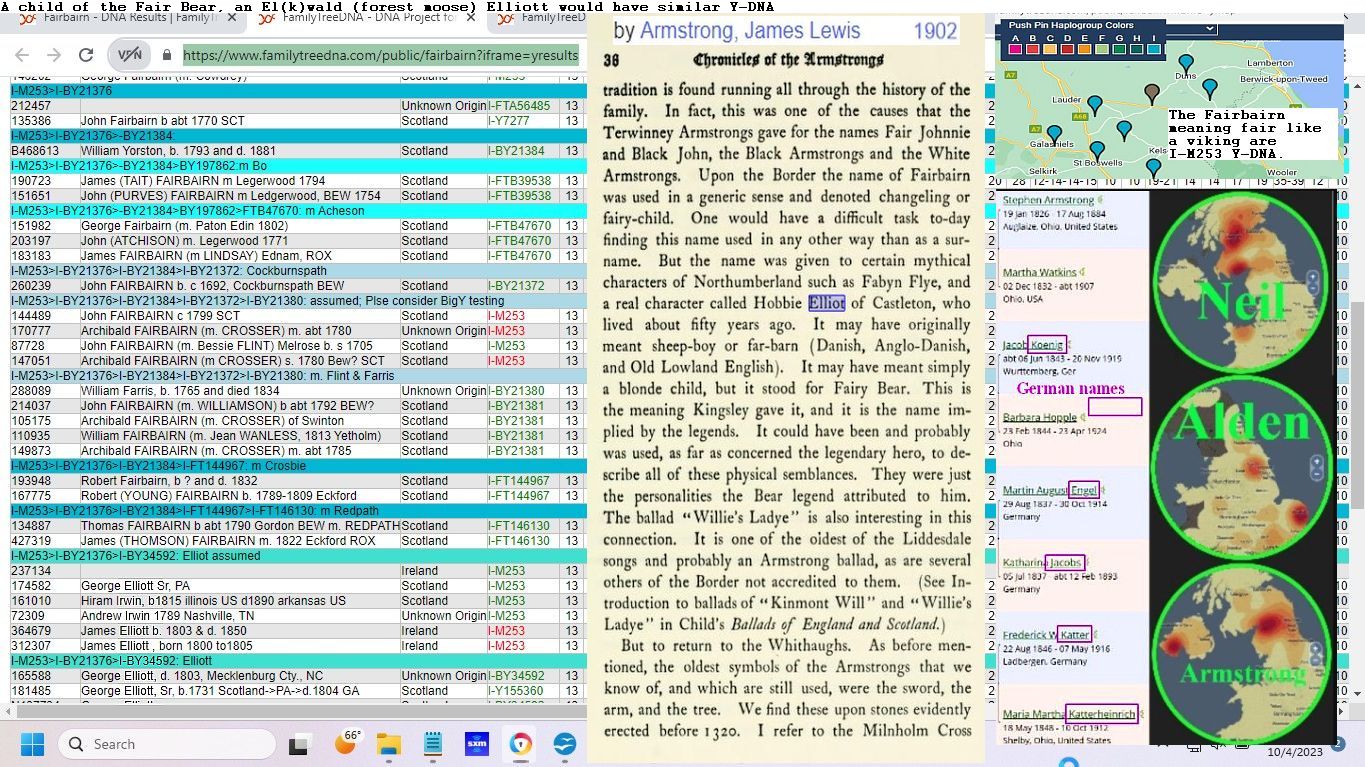
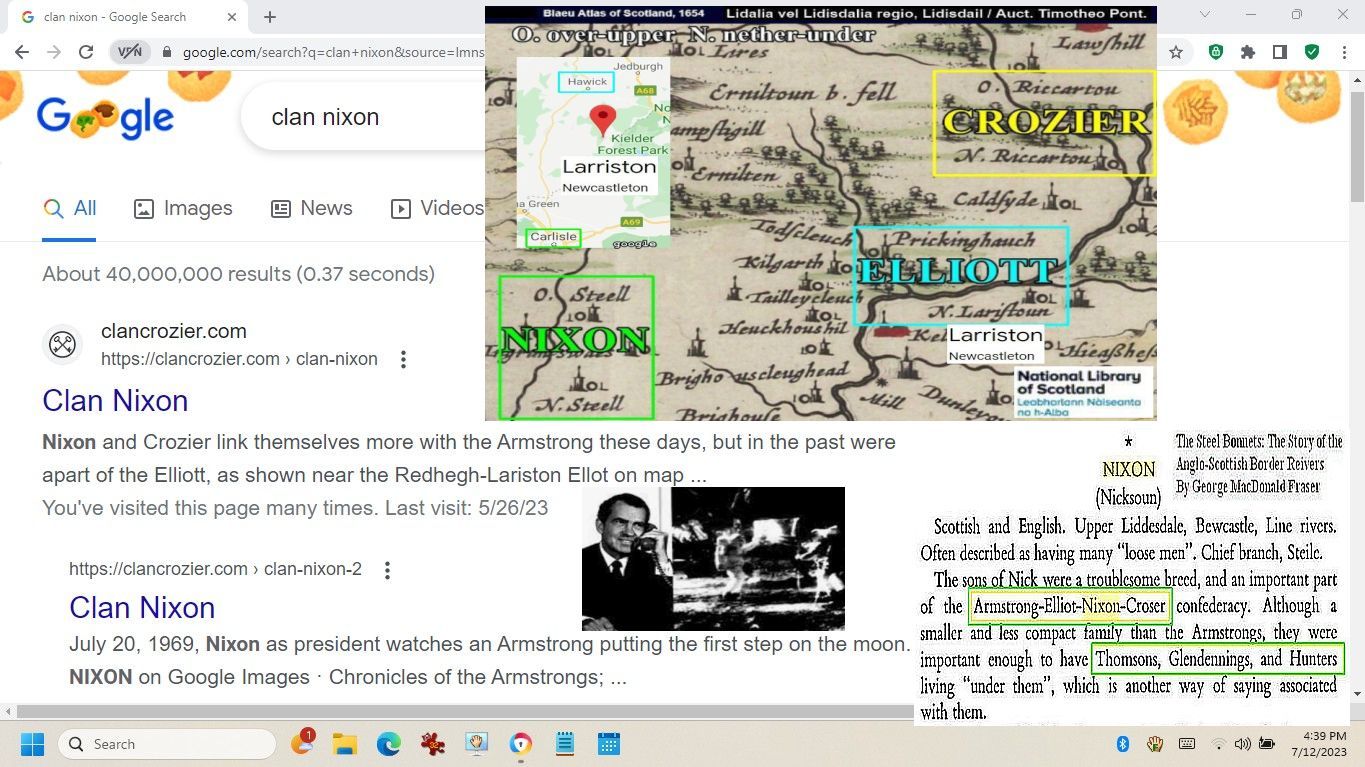
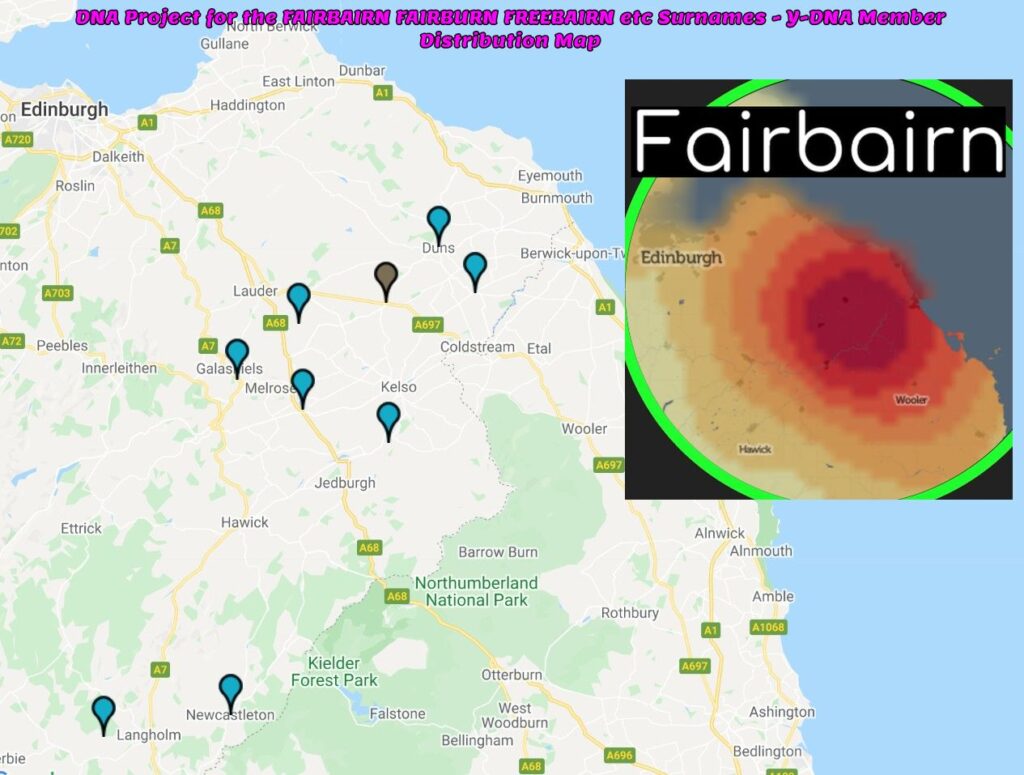
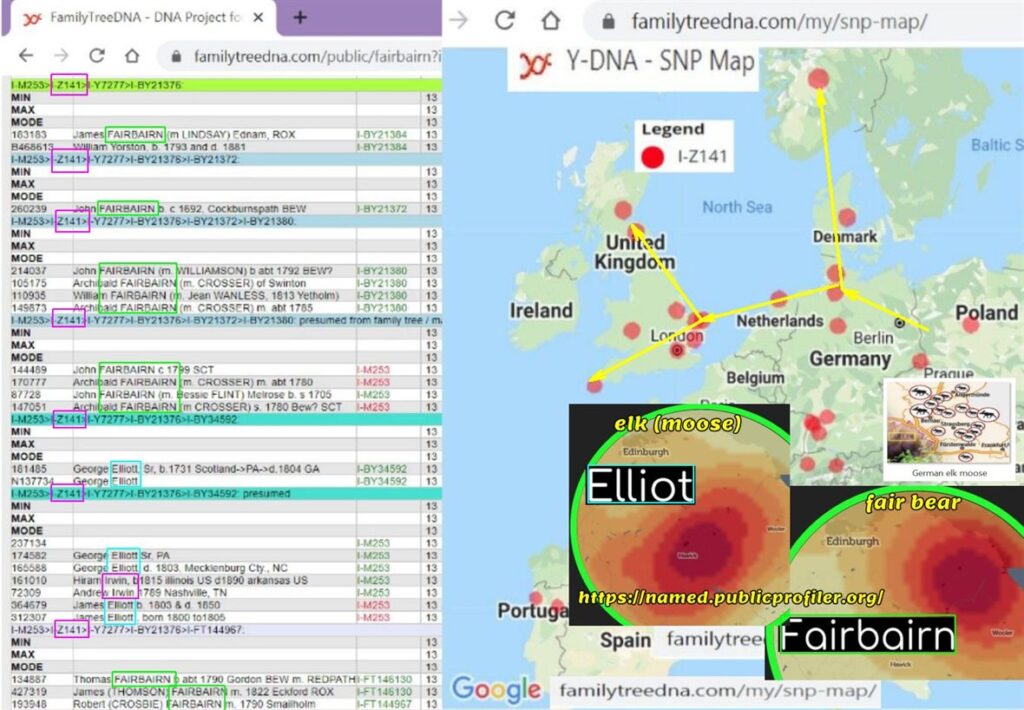
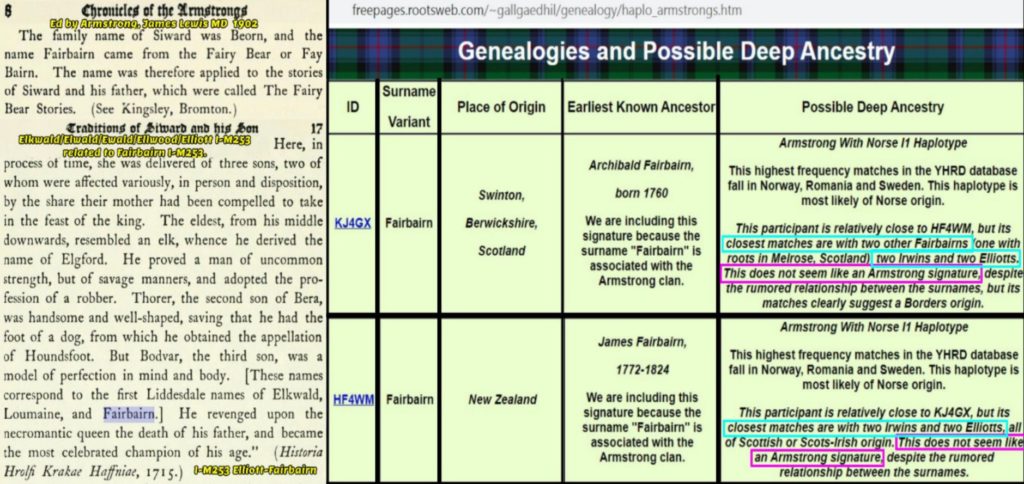

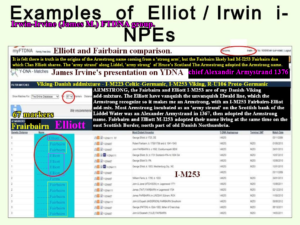
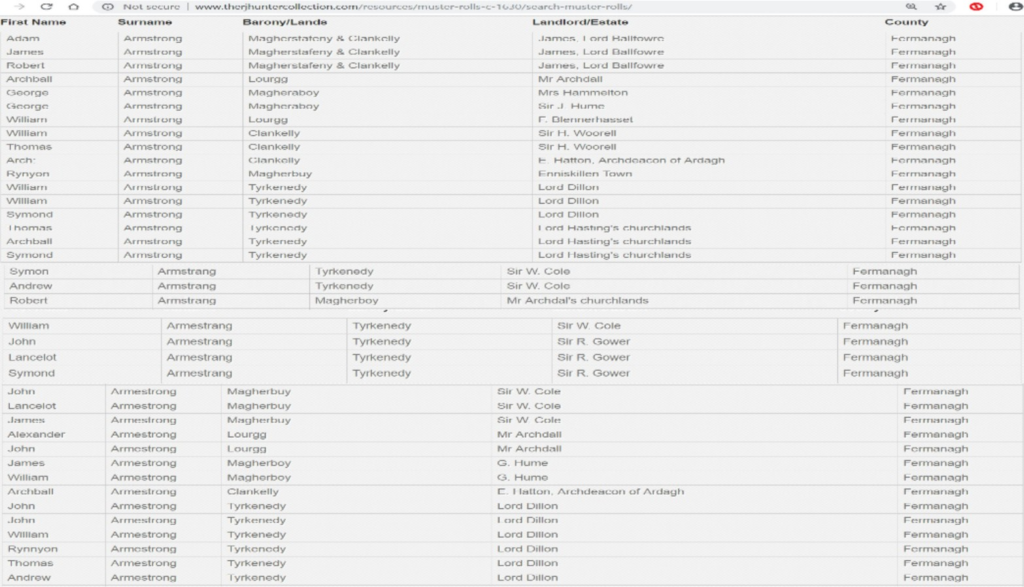


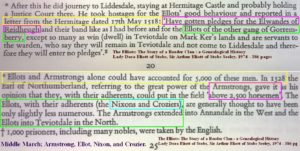








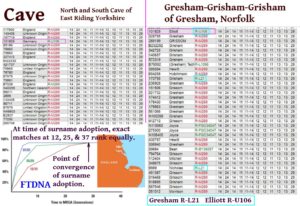

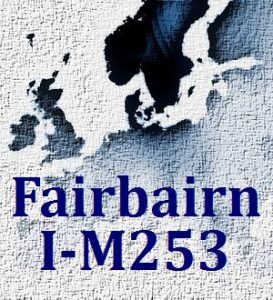
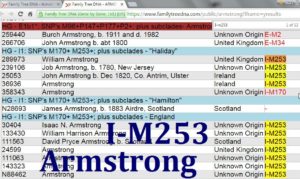
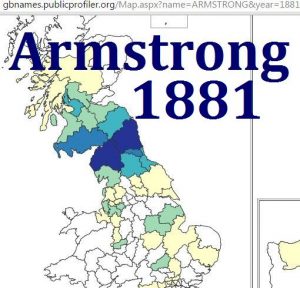
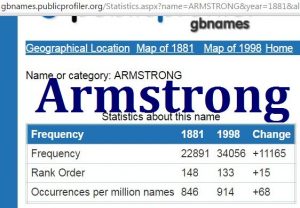
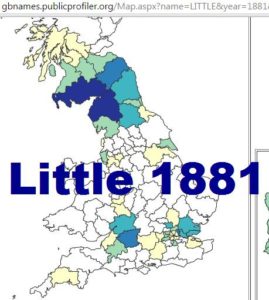
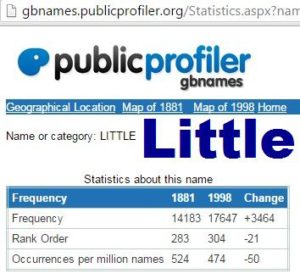
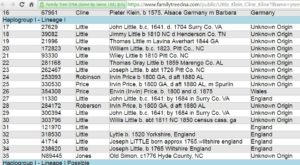
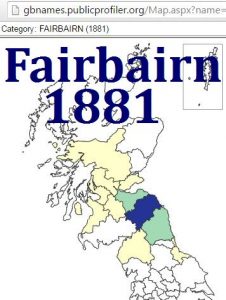
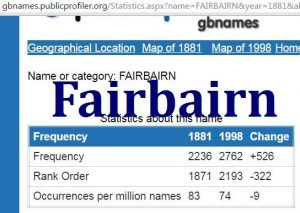
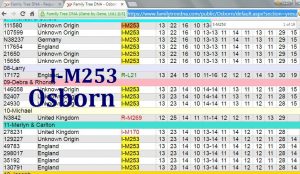
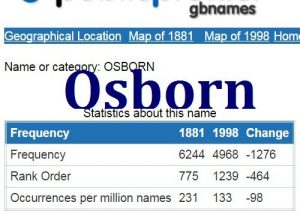
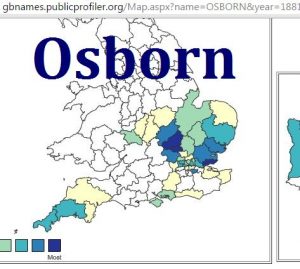
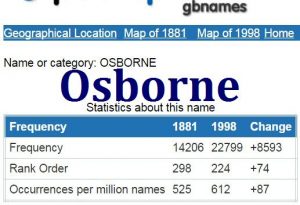
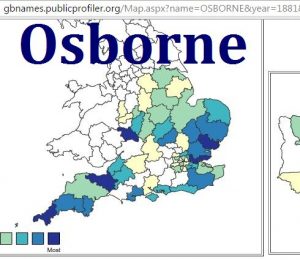


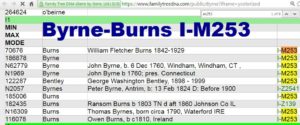
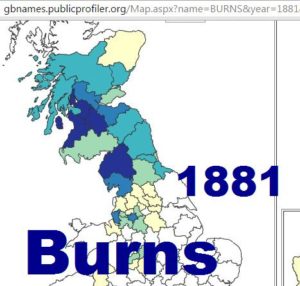
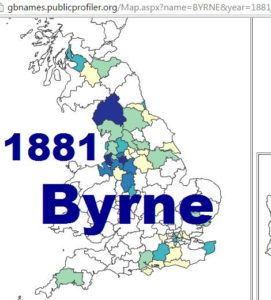
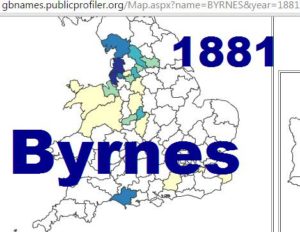
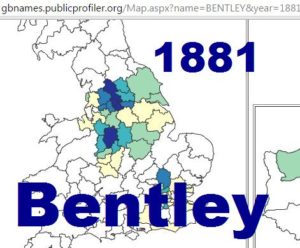
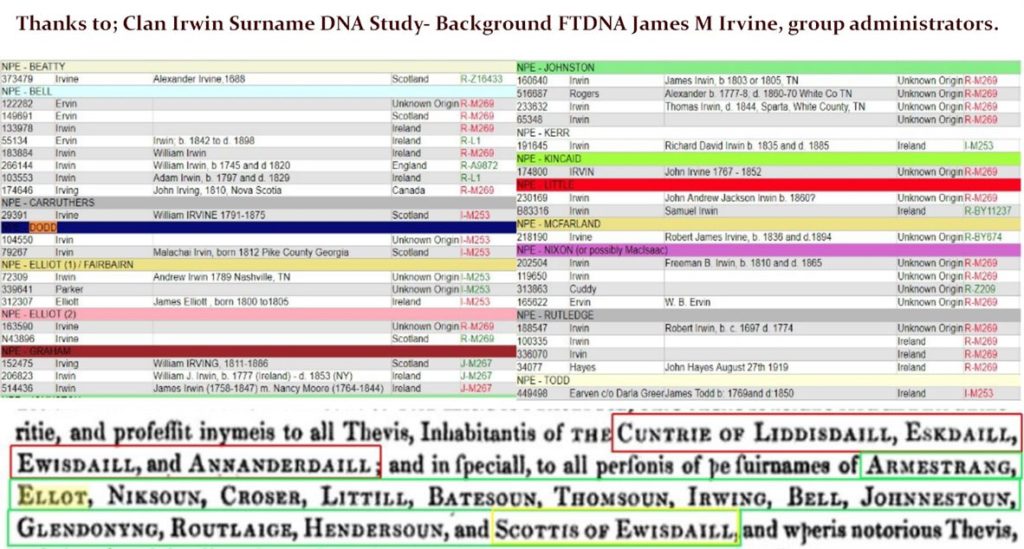
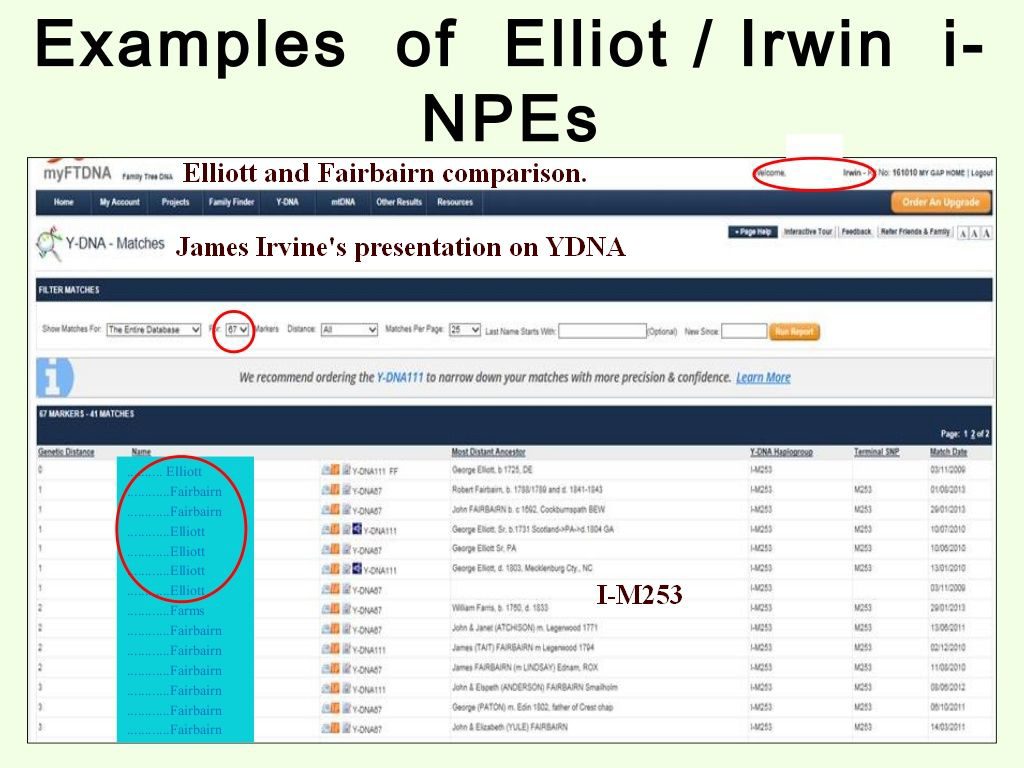
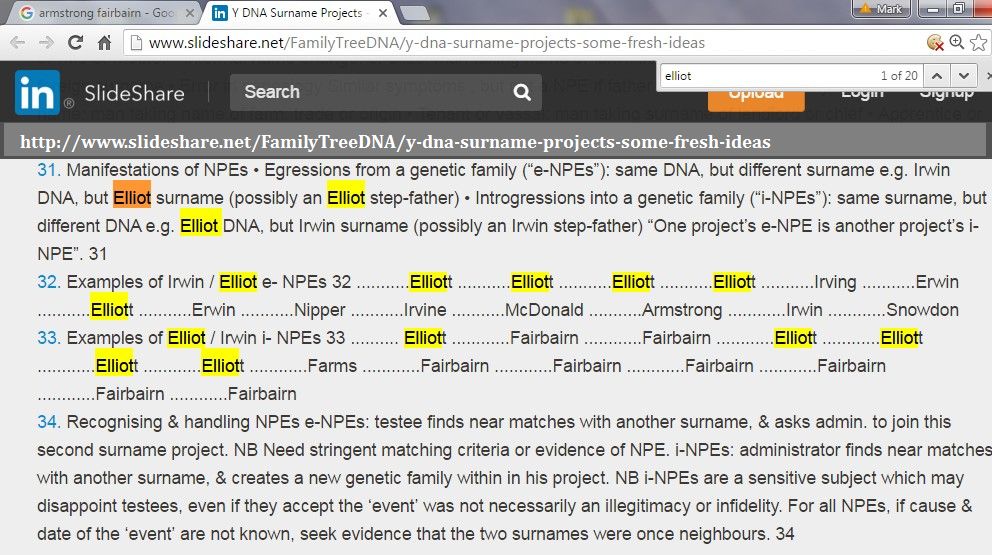

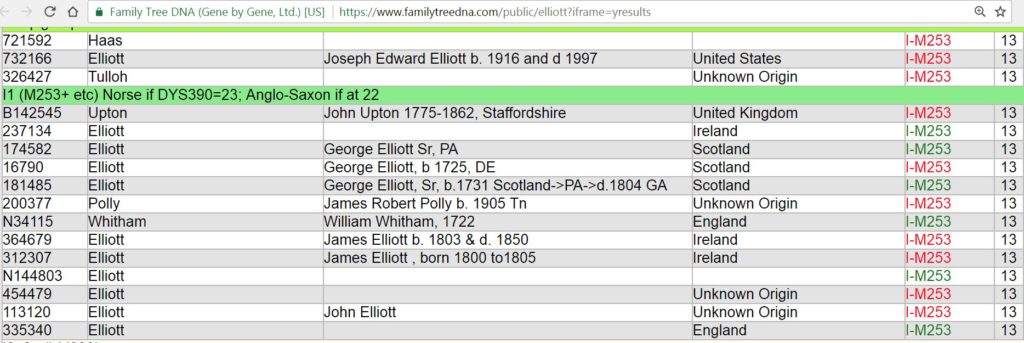
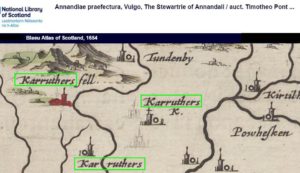

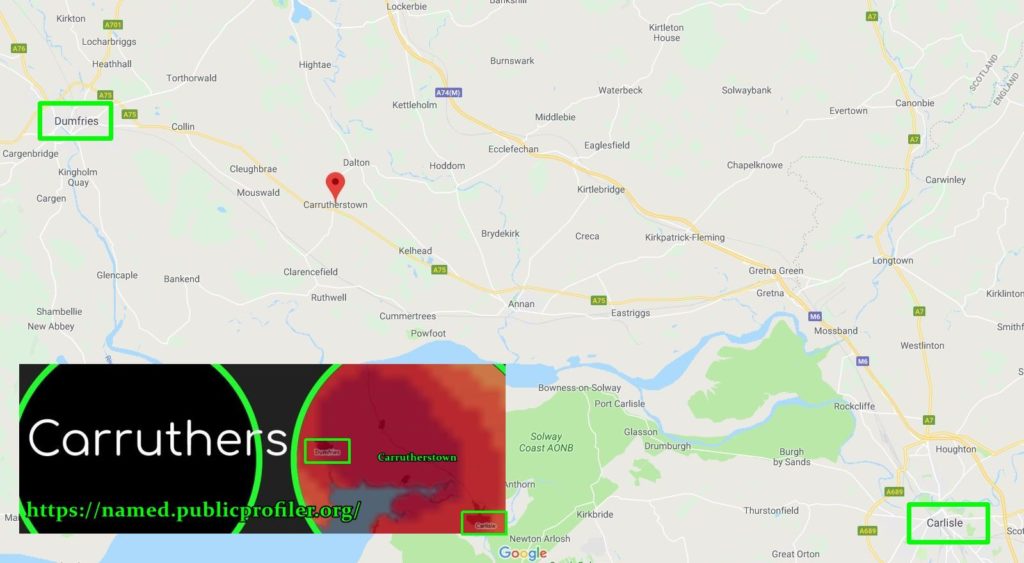
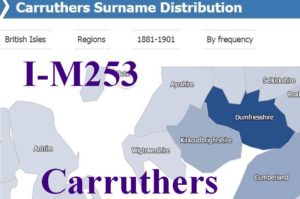

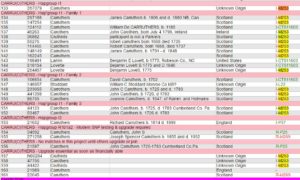

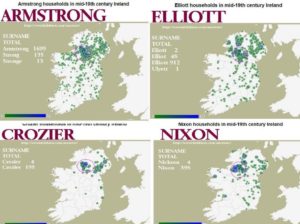
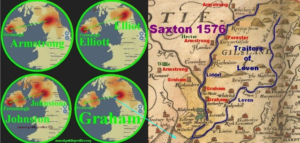


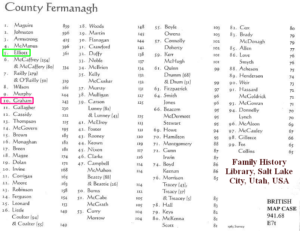

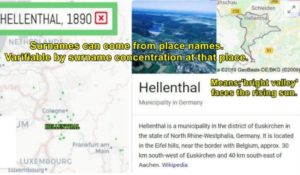
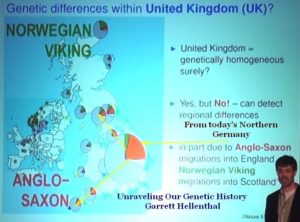
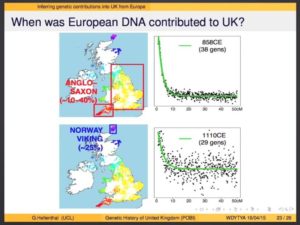
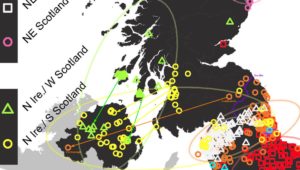
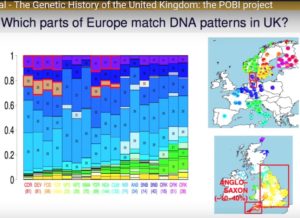

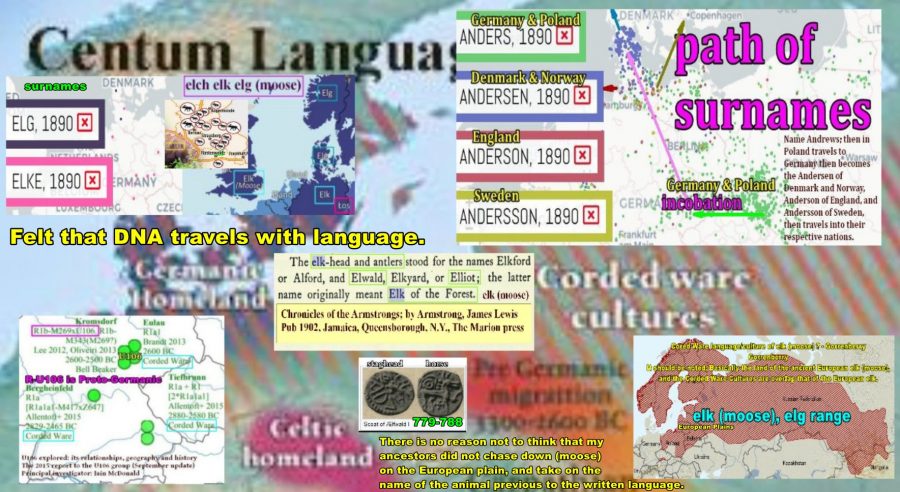
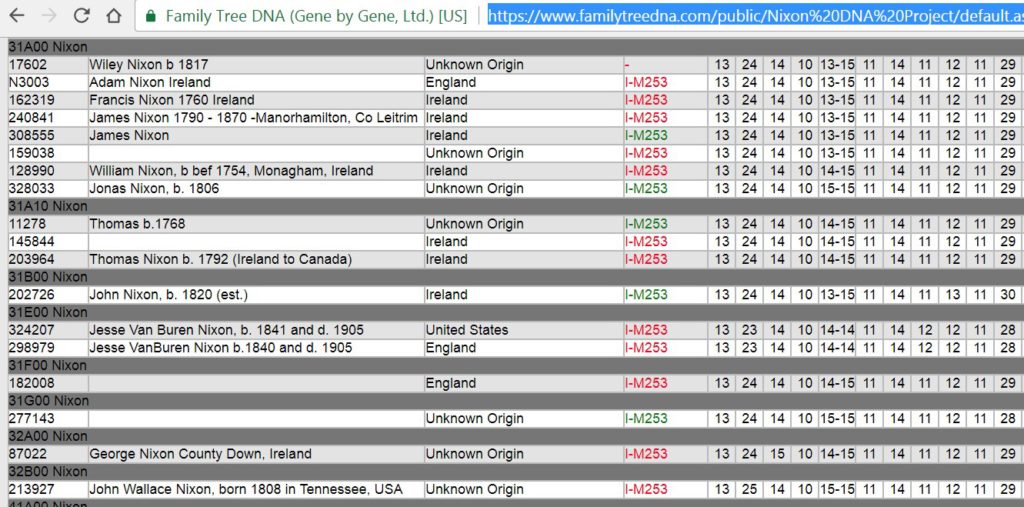


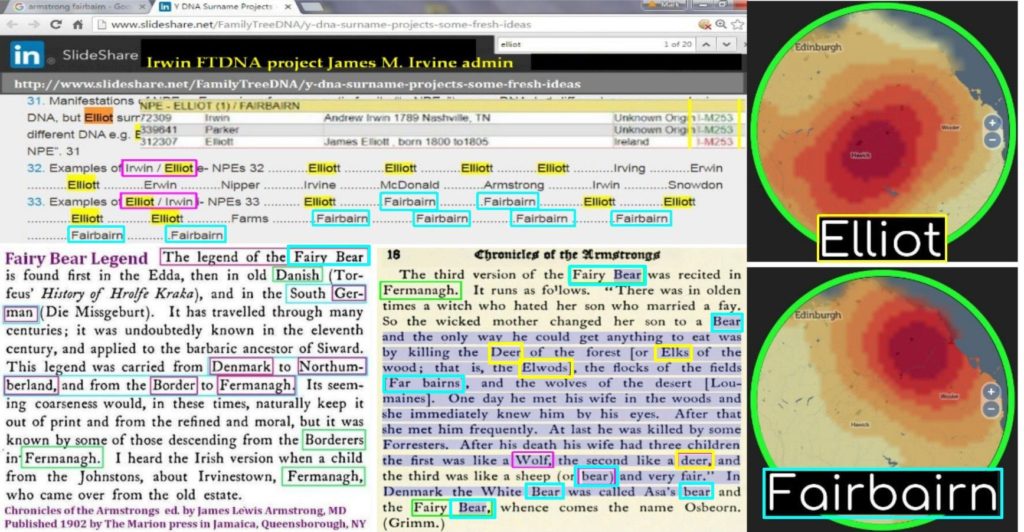


Armstrong Fairbairn I-M253 Y-DNA – Gorrenberry
FTDNA Irwin Clan Surname – Elwald
Search inside (10 results)
Fairbairn
Page 8
The family name of Siward was Beorn, and the name Fairbairn came from the Fairy Bear or Fay Bairn. The name was therefore applied to the stories of Siward and his father, which were called The Fairy Bear Stories. (See Kingsley, Bromton.)
Page 17
“Hringo, king of Upland, had an only son, called Biorn, the most beautiful and most gallant of the northern youth. At an advanced period of life, the king regal dainty. Entreaties and threats being in vain, force was, by the queen’s command, employed for this purpose, and Bera was compelled to swallow one morsel of the bear’s flesh. A second was put into her mouth, but she had an opportunity of putting it aside. She was then dismissed to her father’s house. Here, in process of time, she was delivered of three sons, two of whom were affected variously, in person and disposition, by the share their mother had been compelled to take in the feast of the king. The eldest, from his middle downwards, resembled an elk, whence he derived the name of Elgford. He proved a man of uncommon strength, but of savage manners, and adopted the profession of a robber. Thorer, the second son of Bera, was handsome and well-shaped, saving that he had the foot of a dog, from which he obtained the appellation of Houndsfoot. But Bodvar, the third son, was a model of perfection in mind and body. [These names correspond to the first Liddesdale names of Elkwald, Loumaine, and Fairbairn.] He revenged upon the necromantic queen the death of his father, and became the most celebrated champion of his age.” [Historia Hrolfi Krakae Haffniaey 1715.)
Chronicles of the Armstrongs;
ed by Armstrong, James Lewis MD
Publication date 1902
Topics Armstrong family
Publisher Jamaica, Queensborough, N.Y., The Marion press
Chronicles of the Armstrongs; : Armstrong, James Lewis : Free Download, Borrow, and Streaming : Internet Archive